HAVELIS (OLD MANSIONS)
Patwon ki Haveli (1805)
The first-ever Haveli erected in Jaisalmer, Patwon ki Haveli is the largest and consists of a group of 05 Havelis. Each of the Havelis belonging to five brothers from the same lineage is distinct in design and features. The intricate work on pillars, walls, ceilings, and balconies is admirable. One would be amazed to know that it took around 50 years to build these Havelis.
 The complex with around 60 balconies is also called 'Mansion of Brocade Merchants' owing to the trading of silver and golden thread by the owners. A part of the Haveli is also functioning as a museum, where one can see the artifacts depicting the artwork and culture of old times.
The complex with around 60 balconies is also called 'Mansion of Brocade Merchants' owing to the trading of silver and golden thread by the owners. A part of the Haveli is also functioning as a museum, where one can see the artifacts depicting the artwork and culture of old times.
Salim Singh ki Haveli (1815)
This is one of the most beautiful Havelis built in yellow sandstone with around 38 distinctly designed balconies. One will be surprised to know that the structure was made by interlocking stones with iron rods and without using cement or mortar. The brackets of the arched roof are peacock-shaped, and the front of the Haveli resembles the stern of the ship, which also gives it another name, ‘Jahazmahal’.
This Haveli which has an interesting craftsmanship has an equally rich history. Commissioned by Salim Singh it was rebuilt on an existing structure in 1815. He belonged to the Mehta family, who held a prime minister’s position in King's court from generations. His father was beheaded by the King in front of him when he was just 11 years. By the time he grew up he raised the Haveli's height higher than that of the King's palace.
 However, the additional two storeys of the Haveli were demolished on the orders of the King, and it reduced it to its original 05 storeys, which are still boasting of its glorious past. Salim Singh was very shrewd, and his revengeful nature added to other factors responsible for the decline of the city's glory.
However, the additional two storeys of the Haveli were demolished on the orders of the King, and it reduced it to its original 05 storeys, which are still boasting of its glorious past. Salim Singh was very shrewd, and his revengeful nature added to other factors responsible for the decline of the city's glory.
Nathmal Ji ki Haveli (1885)
Another masterpiece, this Haveli was commissioned by the King for his then Prime Minister Diwan Mohata Nathmal. While its craftsmanship is admirable, it stands distinct for its various features. Its architecture is an amazing fusion of Rajput and Mughal styles. The Haveli was constructed simultaneously by two architect brothers. One will notice that facets of both sides are similar but not exactly the same.
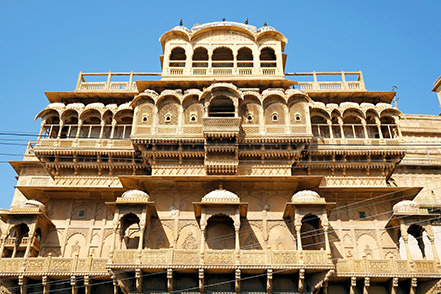 Another interesting feature is that the structure planned around the courtyard is much higher from the rear than its front. Apart from intricate carvings on windows, the paintings on the walls reflect the artist's imagination about the things he might have never seen.
Another interesting feature is that the structure planned around the courtyard is much higher from the rear than its front. Apart from intricate carvings on windows, the paintings on the walls reflect the artist's imagination about the things he might have never seen.
Insider Tip: Add a visit to the Desert festival which is usually organised in the month of February in Jaisalmer. It showcases the spectacular & colourful Rajasthani folk culture. Puppeteers, acrobats, camel tattoo shows, camel races, camel polo, traditional processions, camel mounted bands, folk dances, etc. are some of the highlights of this festival.
GADISAR LAKE (1367)
The man-made lake with arid surroundings is nothing less than an oasis. Rawal Jaisal built it to harvest rainwater for his newly built capital, Jaisalmer. It was remodelled over time by another king of the lineage, Rawal Garisisar, and the lake was renamed after him. There are some temples, shrines, and cenotaphs on the lake's bank, which add to its beauty.
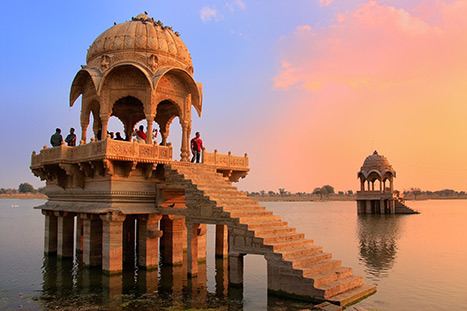
Once the only source of water for the princely state, it is now connected to the canal for a regular water supply and attracts many species of birds. One would love to capture some of the beautiful shots here, as it offers beautiful backdrops.
KULDHARA – THE GHOST VILLAGE (13-19 CENTURY)
This village established around 13th century was once a prosperous village with hundreds of houses.

Being located on the trade route, the villagers were directly benefitted by the traders passing through it, who used to rest around this place. The village and the vicinity have around 400-500 dilapidated houses, which indicates how huge this place was.
The dried river bed, noticeable signs of earthquakes, and gradual declination of population indicate that tough living conditions would have been one of the reasons for people abandoning it.
Salim Singh's revenge was also one of the reasons which affected the economy of the town. He imposed exaggerated taxes on the traders, which forced them to migrate to another region. Similar kinds of situations accompanied by pre-existing challenging living conditions like diminishing water resources would have led the residents of this village to gradually abandon it. There is no concrete reason known to anyone, but most of the assumptions point fingers at Salim Singh. The locals believe that Salim Singh was smitten by the beauty of a girl in this village and wanted to marry her forcibly. Buying the time of one day from him, all the villagers fled overnight to another village. It is also believed that villagers cursed this village, which never let any habitation in this village after them.
BADA BAGH (1743)
The cenotaphs are a very common sight in royal states, and Bada Bagh garden complex in Jaisalmer is one such place to admire cenotaphs constructed by the Maharajas of Jaisalmer.

While there are some minor architectural differences between cenotaphs of different rulers & regions, these distinguish the King, queen, princes, and other royal family members by the structure's size.
SAND DUNES (SAM AND KHURI)
Some might be attracted by forts and palaces, some by the history, but it would not be wrong to say that sands of Thar Desert are the key attractions for everyone. An activity impossible to miss here, one would just want to lose in the endless sight of sand dunes where the company of a camel ‘A desert ship’ adds to its charm and gives a way to explore the surroundings.

Around 40 kms from the city, Sam and Khuri villages (both lying in different directions) provide an opportunity to go for safaris, staying overnight in the camps under the star lit sky or watch a cultural performance by the local artists.
The habitation near the dunes also gives a chance to experience the lifestyle of the local inhabitants amidst the desert's harsh conditions.
NATURAL BIO DIVERSITY
For the wildlife lovers, Desert National Park is an apt place to visit for its abundant variety of fauna and avian life. Here one can encounter Blackbuck, desert fox, chinkara, apart from the migratory birds like Eurasian Griffon Vultures and Saker Falcon.
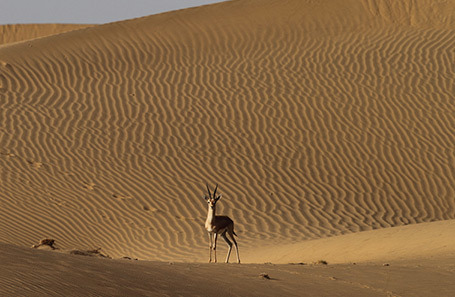
The endangered Great Indian Bustard can also be seen here. Another highlight here is the Wood Fossil Park or Aakal where one can discover and trace geologic tragedies that occurred in the Thar Desert 180 million years ago.
Exuding an age-old aura of valor and royalty the Golden city has everything to satiate an avid traveller. Explore this ‘Golden city’ with us! We, at
Indo Asia Tours, are all about the handcrafted tours, memories, and moments you take out of your trip, and believe us, this escapade will be a life-changing one!

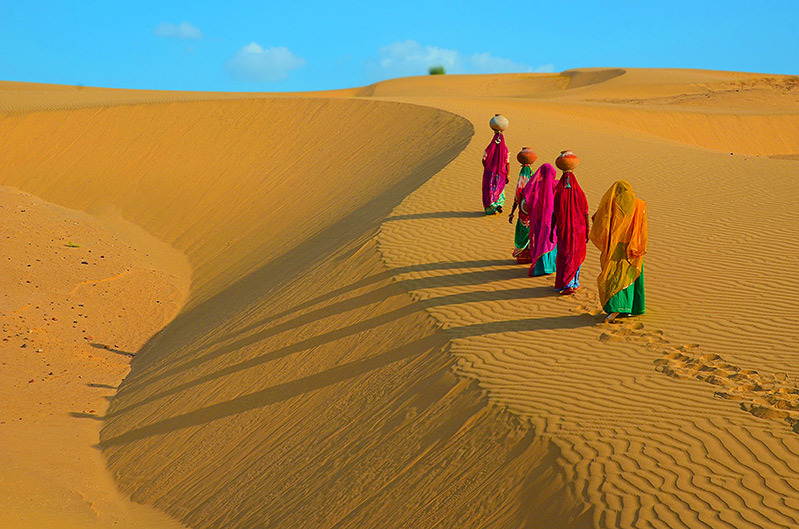
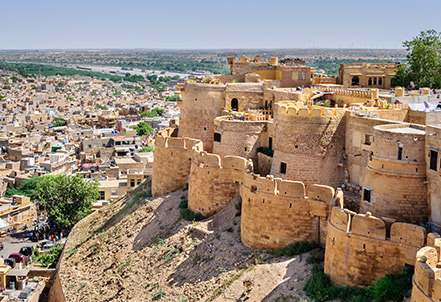 One will also get to see the Hindu temples and centuries old Havelis (old mansions) decorated with ornaments, carved windows, balconies, doors, and archways with many floors and rooms, inside the fort.
One will also get to see the Hindu temples and centuries old Havelis (old mansions) decorated with ornaments, carved windows, balconies, doors, and archways with many floors and rooms, inside the fort.
 The complex with around 60 balconies is also called 'Mansion of Brocade Merchants' owing to the trading of silver and golden thread by the owners. A part of the Haveli is also functioning as a museum, where one can see the artifacts depicting the artwork and culture of old times.
The complex with around 60 balconies is also called 'Mansion of Brocade Merchants' owing to the trading of silver and golden thread by the owners. A part of the Haveli is also functioning as a museum, where one can see the artifacts depicting the artwork and culture of old times.
 However, the additional two storeys of the Haveli were demolished on the orders of the King, and it reduced it to its original 05 storeys, which are still boasting of its glorious past. Salim Singh was very shrewd, and his revengeful nature added to other factors responsible for the decline of the city's glory.
However, the additional two storeys of the Haveli were demolished on the orders of the King, and it reduced it to its original 05 storeys, which are still boasting of its glorious past. Salim Singh was very shrewd, and his revengeful nature added to other factors responsible for the decline of the city's glory.
 Another interesting feature is that the structure planned around the courtyard is much higher from the rear than its front. Apart from intricate carvings on windows, the paintings on the walls reflect the artist's imagination about the things he might have never seen.
Another interesting feature is that the structure planned around the courtyard is much higher from the rear than its front. Apart from intricate carvings on windows, the paintings on the walls reflect the artist's imagination about the things he might have never seen.
 Once the only source of water for the princely state, it is now connected to the canal for a regular water supply and attracts many species of birds. One would love to capture some of the beautiful shots here, as it offers beautiful backdrops.
Once the only source of water for the princely state, it is now connected to the canal for a regular water supply and attracts many species of birds. One would love to capture some of the beautiful shots here, as it offers beautiful backdrops.
 Being located on the trade route, the villagers were directly benefitted by the traders passing through it, who used to rest around this place. The village and the vicinity have around 400-500 dilapidated houses, which indicates how huge this place was.
Being located on the trade route, the villagers were directly benefitted by the traders passing through it, who used to rest around this place. The village and the vicinity have around 400-500 dilapidated houses, which indicates how huge this place was.
 While there are some minor architectural differences between cenotaphs of different rulers & regions, these distinguish the King, queen, princes, and other royal family members by the structure's size.
While there are some minor architectural differences between cenotaphs of different rulers & regions, these distinguish the King, queen, princes, and other royal family members by the structure's size.
 Around 40 kms from the city, Sam and Khuri villages (both lying in different directions) provide an opportunity to go for safaris, staying overnight in the camps under the star lit sky or watch a cultural performance by the local artists.
Around 40 kms from the city, Sam and Khuri villages (both lying in different directions) provide an opportunity to go for safaris, staying overnight in the camps under the star lit sky or watch a cultural performance by the local artists.
 The endangered Great Indian Bustard can also be seen here. Another highlight here is the Wood Fossil Park or Aakal where one can discover and trace geologic tragedies that occurred in the Thar Desert 180 million years ago.
The endangered Great Indian Bustard can also be seen here. Another highlight here is the Wood Fossil Park or Aakal where one can discover and trace geologic tragedies that occurred in the Thar Desert 180 million years ago.
 We can conduct a virtual destination awareness training program for your team or yourself or a virtual tour for your clients. Let us know the destination of your interest along with your convenient date / time and we will be happy to set up a program for you.
We can conduct a virtual destination awareness training program for your team or yourself or a virtual tour for your clients. Let us know the destination of your interest along with your convenient date / time and we will be happy to set up a program for you.
